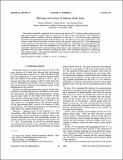Por favor, use este identificador para citar o enlazar a este item:
http://hdl.handle.net/10261/41577COMPARTIR / EXPORTAR:
 SHARE SHARE
 CORE
BASE CORE
BASE
|
|
| Visualizar otros formatos: MARC | Dublin Core | RDF | ORE | MODS | METS | DIDL | DATACITE | |

| Campo DC | Valor | Lengua/Idioma |
|---|---|---|
| dc.contributor.author | Kallosh, Renata | - |
| dc.contributor.author | Ortín Miguel, Tomás | - |
| dc.contributor.author | Peet, Amanda | - |
| dc.date.accessioned | 2011-10-21T12:20:15Z | - |
| dc.date.available | 2011-10-21T12:20:15Z | - |
| dc.date.issued | 1993-06 | - |
| dc.identifier.citation | Physical Review D 47(12): 5400-5407 (1993) | es_ES |
| dc.identifier.issn | 1550-7998 | - |
| dc.identifier.uri | http://hdl.handle.net/10261/41577 | - |
| dc.description | 8 páginas.-- PACS number(s): 04.60.+n, 04.65.+e, 11.17.+y, 97.60.Lf | es_ES |
| dc.description.abstract | We present a detailed calculation of the entropy and action of U(1)2 dilaton black holes and show that both quantities coincide with one quarter of the area of the event horizon. Our methods of calculation make it possible to find an explanation of the rule S=A/4 for all static, spherically symmetric four-dimensional black holes studied so far. We show that the only contribution to the entropy comes from the extrinsic curvature term at the horizon, which gives S=A/4 independently of the charge(s) of the black hole, presence of scalar fields, etc. Previously, this result did not have a general explanation, but was established on a case-by-case basis. The on-shell Lagrangian for maximally supersymmetric extreme dilation black holes is also calculated and shown to vanish, in agreement with the result obtained by taking the limit of the expression obtained for black holes with regular horizon. The physical meaning of the entropy is discussed in relation to the issue of splitting of extreme black holes. | es_ES |
| dc.description.sponsorship | The work of R.K. and A.P. was supported by NSF Grant No. PHY-8612280. The work of R.K. was supported in part by Stanford University. The work of T.O. was supported by a Spanish Government M.E.C. postdoctoral grant. | es_ES |
| dc.language.iso | eng | es_ES |
| dc.publisher | American Physical Society | es_ES |
| dc.rights | openAccess | es_ES |
| dc.title | Entropy and action of dilaton black holes | es_ES |
| dc.type | artículo | es_ES |
| dc.identifier.doi | 10.1103/PhysRevD.47.5400 | - |
| dc.description.peerreviewed | Peer reviewed | es_ES |
| dc.relation.publisherversion | http://dx.doi.org/10.1103/PhysRevD.47.5400 | es_ES |
| dc.identifier.e-issn | 1550-2368 | - |
| dc.type.coar | http://purl.org/coar/resource_type/c_6501 | es_ES |
| item.fulltext | With Fulltext | - |
| item.grantfulltext | open | - |
| item.openairecristype | http://purl.org/coar/resource_type/c_18cf | - |
| item.cerifentitytype | Publications | - |
| item.openairetype | artículo | - |
| item.languageiso639-1 | en | - |
| Aparece en las colecciones: | (IFT) Artículos | |
Ficheros en este ítem:
| Fichero | Descripción | Tamaño | Formato | |
|---|---|---|---|---|
| p5400_1.pdf | 441,44 kB | Adobe PDF |  Visualizar/Abrir |
CORE Recommender
SCOPUSTM
Citations
98
checked on 26-abr-2024
WEB OF SCIENCETM
Citations
94
checked on 25-feb-2024
Page view(s)
337
checked on 05-may-2024
Download(s)
266
checked on 05-may-2024
Google ScholarTM
Check
Altmetric
Altmetric
NOTA: Los ítems de Digital.CSIC están protegidos por copyright, con todos los derechos reservados, a menos que se indique lo contrario.
